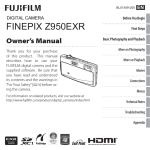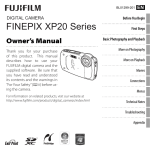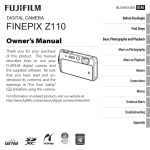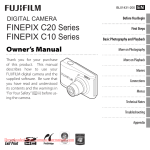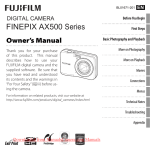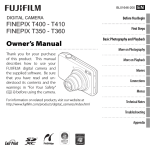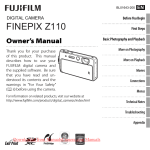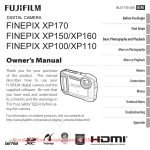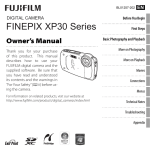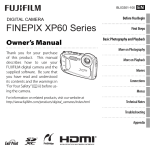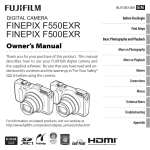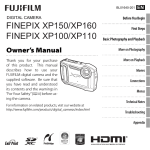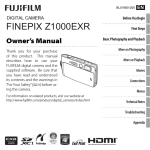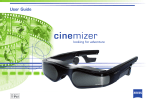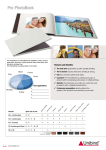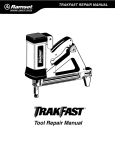Download Fujifilm Z900 Owner's Manual
Transcript
BL01254-200 DIGITAL CAMERA FINEPIX Z900EXR Owner’s Manual Thank you for your purchase of this product. This manual describes how to use your FUJIFILM digital camera and the supplied software. Be sure that you have read and understood its contents and the warnings in “For Your Safety” (P ii) before using the camera. For information on related products, visit our website at http://www.fujifilm.com/products/digital_cameras/index.html EN Before You Begin First Steps Basic Photography and Playback More on Photography More on Playback Movies Connections Menus Technical Notes Troubleshooting Appendix For Your Safety IMPORTANT SAFETY INSTRUCTIONS • Read Instructions: All the safety and operating instructions should be read before the appliance is operated. • Retain Instructions: The safety and operating instructions should be retained for future reference. • Heed Warnings: All warnings on the appliance and in the operating instructions should be adhered to. • Follow Instructions: All operating and use instructions should be followed. Installation Power Sources: This video product should be operated only from the type of power source indicated on the marking label. If you are not sure of the type of power supply to your home, consult your appliance dealer or local power company. For video products intended to operate from battery power, or other sources, refer to the operating instructions. Grounding or Polarization: This video product is equipped with a polarized alternatingcurrent line plug (a plug having one blade wider than the other). This plug will fit into the power outlet only one way. This is a safety feature. If you are unable to insert the plug fully into the outlet, try reversing the plug. If the plug should still fail to fit, contact your electrician to replace your obsolete outlet. Do not defeat the safety purpose of the polarized plug. ii Alternate Warnings: This video product is equipped with a three-wire grounding-type plug, a plug having a third (grounding) pin. This plug will only fit into a grounding-type power outlet. This is a safety feature. If you are unable to insert the plug into the outlet, contact your electrician to replace your obsolete outlet. Do not defeat the safety purpose of the grounding type plug. Overloading: Do not overload wall outlets and extension cords as this can result in a risk of fire or electric shock. Power-Cord Protection: Power-supply cords should be routed so that they are not likely to be walked on or pinched by items placed upon or against them, paying particular attention to cords at plugs, convenience receptacles, and the point where they exit from the appliance. Accessories: Do not place this video product on an unstable cart, stand, tripod, bracket, or table. The video product may fall, causing serious injury to a child or adult, and serious damage to the appliance. Use only with a cart, stand, tripod, bracket, or table recommended by the manufacturer, or sold with the video product. Any mounting of the appliance should follow the manufacturer’s instructions, and should use a mounting accessory recommended by the manufacturer. Ventilation: Slots and openings in the cabinet are provided for ventilation, to ensure reliable operation of the video product and to protect it from overheating, and these openings must not be blocked or covered. The openings should never be blocked by placing the video product on a bed, sofa, rug, or other An appliance and cart combination should similar surface. be moved with care. This video product should not be placed in a Quick stops, excesbuilt-in installation such as a bookcase or rack sive force, and uneven unless proper ventilation is provided or the surfaces may cause manufacturer’s instructions have been adthe appliance and cart hered to. This video product should never be combination to overturn. placed near or over a radiator or heat register. Attachments: Do not use attachments not recommended by the video product manufacturer as they may cause hazards. Water and Moisture: Do not use this video product near water—for example, near a bath tub, wash bowl, kitchen sink, or laundry tub, in a wet basement, or near a swimming pool, and the like. For Your Safety Antennas Outdoor Antenna Grounding: If an outside antenna or cable system is connected to the video product, be sure the antenna or cable system is grounded so as to provide some protection against voltage surges and builtup static charges. Section 810 of the National Electrical Code, ANSI/NFPA No. 70, provides information with respect to proper grounding of the mast and supporting structure, grounding of the lead-in wire to an antenna discharge unit, size of grounding conductors, location of antenna discharge unit, connection to grounding electrodes, and requirements for the grounding electrode. EXAMPLE OF ANTENNA GROUNDING AS PER NATIONAL ELECTRICAL CODE Ground Clamp Antenna Lead in Wire mally follow the operating instructions. Adjust only those controls that are covered by the operating instructions as an improper adjustment of other controls may result in damage and will often require extensive work by a qualified technician to restore the video Object and Liquid Entry: Never push objects product to its normal operation. of any kind into this video product through openings as they may touch dangerous volt- When the video product exhibits a distinct age points or short out parts that could result change in performance—this indicates a in a fire or electric shock. Never spill liquid of need for service. any kind on the video product. Replacement Parts: When replacement parts Use Cleaning: Unplug this video product from the wall outlet before cleaning. Do not use liquid cleaners or aerosol cleaners. Use a damp cloth for cleaning. Lightning: For added protection for this video product receiver during a lightning storm, or when it is left unattended and unused for long periods of time, unplug it from the wall outlet and disconnect the antenna or cable system. This will prevent damage to the video product due to lightning and powerline surges. are required, be sure the service technician has used replacement parts specified by the manufacturer or have the same characteristics as the original part. Unauthorized substitutions may result in fire, electric shock or other hazards. Safety Check: Upon completion of any service or repairs to this video product, ask the service technician to perform safety checks to Service Antenna Electric Service Servicing: Do not attempt to service this video determine that the video product is in proper Discharge Unit Equipment product yourself as opening or removing cov- operating condition. (NEC SECTION ers may expose you to dangerous voltage or 810-20) other hazards. Refer all servicing to qualified Ground Clamps Grounding service personnel. Conductors Damage Requiring Service: Unplug this video Power Service Grounding (NEC SECTION product from the wall outlet and refer servicElectrode System (NEC ART 810-21) ing to qualified service personnel under the 250. PART H) following conditions: Power Lines: An outside antenna system • When the power-supply cord or plug is should not be located in the vicinity of overdamaged. head power lines or other electric light or • If liquid has been spilled, or objects have power circuits, or where it can fall into such fallen into the video product. power lines or circuits. When installing an • If the video product has been exposed to outside antenna system, extreme care should rain or water. be taken to keep from touching such power • If the video product has been dropped or lines or circuits as contact with them might the cabinet has been damaged. be fatal. If the video product does not operate nor- iii For Your Safety Be sure to read these notes before use WARNING Safety Notes • Make sure that you use your camera correctly. Read these safety notes and your Owner’s Manual carefully before use. • After reading these safety notes, store them in a safe place. About the Icons The icons shown below are used in this document to indicate the severity of the injury or damage that can result if the information indicated by the icon is ignored and the product is used incorrectly as a result. WARNING CAUTION This icon indicates that death or serious injury can result if the information is ignored. This icon indicates that personal injury or material damage can result if the information is ignored. The icons shown below are used to indicate the nature of the instructions which are to be observed. Triangular icons tell you that this information requires attention (“Important”). Circular icons with a diagonal bar tell you that the action indicated is prohibited (“Prohibited”). Filled circles with an exclamation mark indicate an action that must be performed (“Required”). WARNING Unplug from power socket Avoid exposure to water iv If a problem arises, turn the camera off, remove the battery, and disconnect and unplug the AC power adapter. Continued use of the camera when it is emitting smoke, is emitting any unusual odor, or is in any other abnormal state can cause a fire or electric shock. Contact your FUJIFILM dealer. Do not allow water or foreign objects to enter the camera. If water or foreign objects get inside the camera, turn the camera off, remove the battery, and disconnect and unplug the AC power adapter. Continued use of the camera can cause a fire or electric shock. Contact your FUJIFILM dealer. Do not use in the bathroom or shower Do not disassemble Do not touch internal parts Do not use the camera in the bathroom or shower. This can cause a fire or electric shock. Never attempt to change or take apart the camera (never open the case). Failure to observe this precaution can cause fire or electric shock. Should the case break open as the result of a fall or other accident, do not touch the exposed parts. Failure to observe this precaution could result in electric shock or in injury from touching the damaged parts. Remove the battery immediately, taking care to avoid injury or electric shock, and take the product to the point of purchase for consultation. Do not change, heat or unduly twist or pull the connection cord and do not place heavy objects on the connection cord. These actions could damage the cord and cause a fire or electric shock. If the cord is damaged, contact your FUJIFILM dealer. Do not place the camera on an unstable surface. This can cause the camera to fall or tip over and cause injury. Never attempt to take pictures while in motion. Do not use the camera while you are walking or driving a vehicle. This can result in you falling down or being involved in a traffic accident. Do not touch any metal parts of the camera during a thunderstorm. This can cause an electric shock due to induced current from the lightning discharge. Do not use the battery except as specified. Load the battery as shown by the indicator. Do not heat, change or take apart the battery. Do not drop or subject the battery to impacts. Do not store the battery with metallic products. Any of these actions can cause the battery to burst or leak and cause fire or injury as a result. Use only the battery or AC power adapters specified for use with this camera. Do not use voltages other than the power supply voltage shown. The use of other power sources can cause a fire. If the battery leaks and fluid gets in contact with your eyes, skin or clothing, flush the affected area with clean water and seek medical attention or call an emergency number right away. For Your Safety WARNING CAUTION Do not use the charger to charge batteries other than those specified here. The supplied battery charger is for use only with the type of battery supplied with the camera. Using the charger to charge conventional batteries or other types of rechargeable batteries can cause the battery to leak fluid, overheat or burst. When carrying the battery, install it in a digital camera or keep it in the hard case. When storing the battery, keep it in the hard case. When discarding, cover the battery terminals with insulation tape. Contact with other metallic objects or batteries could cause the battery to ignite or burst. Keep memory cards out of the reach of small children. Because memory cards are small, they can be swallowed by children. Be sure to store memory cards out of the reach of small children. If a child swallows a memory card, seek medical attention or call an emergency number. Do not use this camera in locations affected by oil fumes, steam, humidity or dust. This can cause a fire or electric shock. Do not leave this camera in places subject to extremely high temperatures. Do not leave the camera in locations such as a sealed vehicle or in direct sunlight. This can cause a fire. Keep out of the reach of small children. This product could cause injury in the hands of a child. Do not place heavy objects on the camera. This can cause the heavy object to tip over or fall and cause injury. Do not move the camera while the AC power adapter is still connected. Do not pull on the connection cord to disconnect the AC power adapter. This can damage the power cord or cables and cause a fire or electric shock. Do not use the AC power adapter when the plug is damaged or the plug socket connection is loose. This could cause a fire or electric shock. Do not cover or wrap the camera or the AC power adapter in a cloth or blanket. This can cause heat to build up and distort the casing or cause a fire. When you are cleaning the camera or you do not plan to use the camera for an extended period, remove the battery and disconnect and unplug the AC power adapter. Failure to do so can cause a fire or electric shock. Unplug from power socket When charging ends, unplug the charger from the power socket. Leaving the charger plugged into the power socket can cause a fire. Using a flash too close to a person’s eyes may temporarily affect the eyesight. Take particular care when photographing infants and young children. When a memory card is removed, the card could come out of the slot too quickly. Use your finger to hold it and gently release the card. Injury could result to those struck by the ejected card. Request regular internal testing and cleaning for your camera. Build-up of dust in your camera can cause a fire or electric shock. Contact your FUJIFILM dealer to request internal cleaning every two years. Please note that this service is not free of charge. v For Your Safety ■ Charging the Battery Charge the battery in the supplied battery charger. Charging times will increase at ambient temperatures below +10 °C (+50 °F) or above +35 °C (+95 °F). Do not attempt to The following describes the proper use of charge the battery at temperatures above batteries and how to prolong their life. Incor- 40 °C (+104 °F); at temperatures below 0 °C rect use can shorten battery life or cause leak- (+32 °F), the battery will not charge. age, overheating, fire, or explosion. Do not attempt to recharge a fully charged Li-ion Batteries battery. The battery does not however need Read this section if your camera uses a to be fully discharged before charging. rechargeable Li-ion battery. The battery may be warm to the touch immeThe battery is not charged at shipment. diately after charging or use. This is normal. Charge the battery before use. Keep the bat■ Battery Life tery in its case when not in use. At normal temperatures, the battery can be ■ Notes on the Battery recharged about 300 times. A noticeable deThe battery gradually loses its charge when crease in the length of time the battery will not in use. Charge the battery one or two hold a charge indicates that it has reached days before use. the end of its service life and should be reBattery life can be extended by turning the placed. The Battery and Power Supply Note: Check the type of battery used in your camera and read the appropriate sections. ■ Cautions: Handling the Battery • Do not transport or store with metal objects such as necklaces or hairpins. • Do not expose to flame or heat. • Do not disassemble or modify. • Use with designated chargers only. • Do not drop or subject to strong physical shocks. • Do not expose to water. • Keep the terminals clean. • The battery and camera body may become warm to the touch after extended use. This is normal. AA Alkaline/Rechargeable Ni-MH Batteries Read this section if your camera uses AA alkaline or rechargeable AA Ni-MH batteries. Information on compatible battery types may be found elsewhere in the camera manual. ■ Cautions: Handling the Batteries • Do not expose to water, flame, or heat, or ■ Storage store in warm or humid conditions. Battery capacity decreases at low tempera- Performance may be impaired if the battery is • Do not transport or store with metal objects tures; a depleted battery may not function at left unused for extended periods when fully such as necklaces or hairpins. when cold. Keep a fully charged spare bat- charged. Run the battery flat before storing it. • Do not disassemble or modify the batteries tery in a warm place and exchange as nec- If the camera will not be used for an extended or battery casing. essary, or keep the battery in your pocket or period, remove the battery and store it in a • Do not subject to strong physical shocks. other warm place and insert it in the camera dry place with an ambient temperature of • Do not use batteries that are leaking, deonly when shooting. Do not place the bat- from +15 °C to +25 °C (+59 °F to +77 °F). Do formed, or discolored. tery in direct contact with hand warmers or not store in locations exposed to extremes of • Keep out of reach of infants and small chilother heating devices. dren. temperature. • Insert in the correct orientation. camera off when not in use. vi For Your Safety • Do not mix old and new batteries, batteries with different charge levels, or batteries of different types. • If the camera will not be used for an extended period, remove the batteries. Note that the camera clock will be reset. • The batteries may be warm to the touch immediately after use. Turn the camera off and allow the batteries to cool before handling. • Battery capacity tends to decrease at low temperatures. Keep spare batteries in a pocket or other warm place and exchange as necessary. Cold batteries may recover some of their charge when warmed. • Fingerprints and other stains on the battery terminals can impair battery performance. Thoroughly clean the terminals with a soft, dry cloth before inserting them in the camera. ■ Ni-MH Batteries The capacity of Ni-MH batteries may be temporarily reduced when new, after long periods of disuse, or if they are repeatedly recharged before being fully discharged. This is normal and does not indicate a malfunction. Capacity can be increased by repeatedly discharging the batteries using the discharge option in the camera setup menu and recharging them using a battery charger. Q CAUTION: Do not use the discharge option with alkaline batteries. The camera draws a small amount of current even when off. Ni-MH batteries that have been left in the camera for an extended period may be drawn down to the point that they no longer hold a charge. Battery performance may also drop if the batteries are run down in a device such as a flashlight. Use the discharge option in the camera setup menu If the batteries leak, clean the battery to discharge Ni-MH batteries. Batteries that compartment thoroughly before in- no longer hold a charge even after repeatserting new batteries. edly being discharged and recharged have reached the end of their service life and must If fluid from the battery comes into be replaced. contact with skin or clothing, flush the affected area with water. If fluid Ni-MH batteries can be recharged in a batenters your eyes, immediately flush the tery charger (sold separately). Batteries may affected area with water and seek become warm to the touch after charging. medical attention. Do not rub your eyes. Refer to the instructions provided with the Failure to observe this precaution could charger for more information. Use the charresult in permanent visual impairment. ger with compatible batteries only. AC Power Adapters (Available Separately) This section applies to all camera models. Use only FUJIFILM AC power adapters designated for use with this camera. Other adapters could damage the camera. • The AC power adapter is for indoor use only. • Be sure the DC plug is securely connected to the camera. • Turn the camera off before disconnecting the adapter. Disconnect the adapter by the plug, not the cable. • Do not use with other devices. • Do not disassemble. • Do not expose to high heat and humidity. • Do not subject to strong physical shocks. • The adapter may hum or become hot to the touch during use. This is normal. • If the adapter causes radio interference, reorient or relocate the receiving antenna. Ni-MH batteries gradually lose their charge when not in use. ■ Disposal Dispose of used batteries in accord with local regulations. vii For Your Safety Using the Camera Do not aim the camera at extremely bright light sources, such as the sun in a cloudless sky. Failure to observe this precaution could damage the camera image sensor. Take Test Shots Before taking photographs on important occasions (such as at weddings or before taking the camera on a trip), take a test shot and view the result in the LCD monitor to ensure that the camera is functioning normally. FUJIFILM Corporation can not accept liability for damages or lost profits incurred as a result of product malfunction. Notes on Copyright Unless intended solely for personal use, images recorded using your digital camera system cannot be used in ways that infringe copyright laws without the consent of the owner. Note that some restrictions apply to the photographing of stage performances, entertainments, and exhibits, even when intended purely for personal use. Users are also asked to note that the transfer of memory cards containing images or data protected under copyright laws is only permissible within the restrictions imposed by those copyright laws. Handling To ensure that images are recorded correctly, do not subject the camera to impact or physical shocks while images are being recorded. viii Liquid Crystal In the event that the LCD monitor is damaged, care should be taken to avoid contact with liquid crystal. Take the urgent action indicated should any of the following situations arise: • If liquid crystal comes in contact with your skin, clean the area with a cloth and then wash thoroughly with soap and running water. • If liquid crystal enters your eyes, flush the affected eye with clean water for at least 15 minutes and then seek medical assistance. • If liquid crystal is swallowed, rinse your mouth thoroughly with water. Drink large quantities of water and induce vomiting, then seek medical assistance. Electrical Interference This camera may interfere with hospital or aviation equipment. Consult with hospital or airline staff before using the camera in a hospital or on an aircraft. Color Television Systems NTSC (National Television System Committee) is a color television telecasting specification adopted mainly in the U.S.A., Canada, and Japan. PAL (Phases Alternation by Line) is a color television system adopted mainly in European countries and China. Exif Print (Exif Version 2.3) Exif Print is a newly revised digital camera file format in which information stored with phoAlthough the display is manufactured using tographs is used for optimal color reproducextremely high-precision technology, it may tion during printing. contain pixels that are always lit or that do not IMPORTANT NOTICE: light. This is not a malfunction, and images reRead Before Using the Software corded with the product are unaffected. Direct or indirect export, in whole or in part, of licensed software without the permission Trademark Information xD-Picture Card and E are trademarks of the applicable governing bodies is proof FUJIFILM Corporation. The typefaces in- hibited. cluded herein are solely developed by DynaComware Taiwan Inc. Macintosh, QuickTime, and Mac OS are trademarks of Apple Inc. in the U.S.A. and other countries. Windows 7, Windows Vista, and the Windows logo are trademarks of the Microsoft group of companies. Adobe and Adobe Reader are either trademarks or registered trademarks of Adobe Systems Incorporated in the U.S.A. and/or other countries. The SDHC and SDXC logos are trademarks of SD-3C, LLC. The HDMI logo is a trademark. YouTube is a trademark of Google Inc. All other trade names mentioned in this manual are the trademarks or registered trademarks of their respective owners. About This Manual Before using the camera, read this manual and the warnings in “For Your Safety” (P ii). For information on specific topics, consult the sources below. Table of Contents .............................P .............................P xi The “Table of Contents” gives an overview of the entire manual. The principal camera operations are listed here. Troubleshooting .......................... P 105 Having a specific problem with the camera? Find the answer here. Warning Messages and Displays ... P 111 Find out what’s behind that flashing icon or error message in the display. Memory Cards Pictures can be stored in the camera’s internal memory or on optional SD, SDHC, and SDXC memory cards (P 17), referred to in this manual as “memory cards.” ix The HOME Button ■ Taking Pictures During Playback y To return instantly to shooting mode, press the HOME button. Shoot View ■ Turning the Camera on in Playback Mode y When the camera is off, playback can be started by pressing the HOME button for about a second. Press the HOME button again to turn the camera off. ■ Viewing Pictures from the Playback Menu y When playback menu is displayed, exit to viewing pictures by pressing the HOME button. View a Playback menu x Table of Contents For Your Safety ..................................................................ii IMPORTANT SAFETY INSTRUCTIONS ..................................ii Safety Notes ....................................................................iv About This Manual ...........................................................ix The HOME Button ..............................................................x Before You Begin Symbols and Conventions.................................................1 Supplied Accessories .........................................................1 Parts of the Camera ..........................................................2 Camera Displays (Touch Panel).........................................4 Shooting ........................................................................4 Playback.........................................................................5 The Touch Panel Display....................................................6 Tap.................................................................................6 Scroll..............................................................................6 Playback Zoom................................................................6 Rotating the Camera ........................................................8 Shooting ........................................................................8 Playback.........................................................................9 Touch Panel Icons ...........................................................10 Shooting ......................................................................10 Playback.......................................................................11 First Steps Charging the Battery ......................................................12 Inserting the Battery and a Memory Card.....................14 Compatible Memory Cards .............................................17 Turning the Camera on and Off ......................................19 Shooting Mode ..............................................................19 Playback Mode ...............................................................19 Basic Setup ......................................................................21 Basic Photography and Playback Taking Pictures in R (E AUTO) Mode.............23 Viewing Pictures .............................................................28 More on Photography Shooting Mode ................................................................29 E EXR .................................................................30 B AUTO .......................................................................30 R TOUCH EXR AUTO/J TOUCH & SHOOT..................31 SP SCENE POSITION.......................................................32 r MOTION PANORAMA 360 .......................................34 D NATURAL LIGHT ......................................................36 C NATURAL & N........................................................36 P PROGRAM AE ..............................................................37 xi Table of Contents Focus Lock ........................................................................38 d Exposure Compensation ..........................................40 N Using the Flash (Super-Intelligent Flash) .................41 h Using the Self-Timer .................................................43 F Macro Mode (Close-ups) ...........................................44 b Intelligent Face Detection .......................................45 R Continuous Shooting ...............................................46 n Face Recognition ....................................................47 Adding New Faces ..........................................................47 Editing Existing Data ......................................................49 Adding Faces Automatically ...........................................50 More on Playback Playback Options.............................................................52 I Favorites: Rating Pictures .........................................52 Playback Zoom ...............................................................53 G Multi-Frame Playback .............................................55 e Deleting Pictures ........................................................57 H Image Search............................................................58 L PhotoBook Assist .....................................................60 Creating a PhotoBook.....................................................60 Viewing Photobooks ......................................................61 Editing and Deleting Photobooks ...................................61 xii j Edit ............................................................................62 f COLLAGE .................................................................63 C IMAGE ROTATE .........................................................64 G CROP .......................................................................64 O RESIZE .....................................................................65 B RED EYE REMOVAL...................................................65 Viewing Panoramas ........................................................66 Movies Recording Movies ............................................................67 Movie Frame Size ...........................................................68 Viewing Movies ...............................................................69 Connections Connecting the Camera to High Definition (HD) TVs ....70 Printing Pictures via USB ................................................72 Viewing Pictures on a Computer ....................................74 Windows: Installing MyFinePix Studio ...........................74 Macintosh: Installing FinePixViewer...............................76 Connecting the Camera ..................................................78 Table of Contents Menus Using the Menus: Shooting Mode ..................................81 Using the Shooting Menu...............................................81 Shooting Menu Options .................................................82 d EXP. COMPENSATION...............................................82 N ISO........................................................................82 O IMAGE SIZE ............................................................83 T IMAGE QUALITY .....................................................83 W MOVIE MODE .........................................................84 U DYNAMIC RANGE ...................................................84 P FILM SIMULATION ..................................................84 D WHITE BALANCE ....................................................85 R CONTINUOUS SHOOTING SETUP ...............................85 b FACE DETECTION ....................................................85 F AF MODE ...............................................................86 F MOVIE AF MODE ....................................................86 c BEST FRAMING ......................................................87 o SILENT MODE.........................................................87 M SET-UP ..................................................................87 Using the Menus: Playback Mode ..................................88 Using the Playback Menu ...............................................88 Playback Menu Options..................................................88 m PHOTOBOOK ASSIST................................................88 l FAVORITES .............................................................88 h PICTURE COMPARE .................................................88 b IMAGE SEARCH ......................................................89 c EDIT ......................................................................89 I SLIDE SHOW ..........................................................89 D PROTECT................................................................90 E COPY.....................................................................90 i ERASE FACE RECOG. ................................................91 A ERASE ...................................................................91 j MARK FOR UPLOAD TO ............................................92 o SILENT MODE.........................................................93 M SET-UP ..................................................................93 xiii Table of Contents The Setup Menu ..............................................................94 Using the Setup Menu....................................................94 Setup Menu Options ......................................................94 A IMAGE DISP. ...........................................................94 B FRAME NO. ............................................................95 L DUAL IS MODE .......................................................95 a ILLUMINATION .......................................................95 D DIGITAL ZOOM .......................................................96 F DATE/TIME ............................................................96 I VOLUME ................................................................97 b SOUND ..................................................................97 J LCD BRIGHTNESS ....................................................97 K FORMAT ................................................................97 L a ......................................................97 M AUTO POWER OFF ..................................................98 N TIME DIFFERENCE ...................................................98 B RED EYE REMOVAL .................................................98 m AUTOROTATE PB .....................................................99 O BACKGROUND COLOR..............................................99 S POWER MANAGEMENT ...........................................99 R RESET..................................................................100 h CALIBRATION .......................................................100 i VERSION INFO ......................................................100 xiv Technical Notes Optional Accessories .....................................................101 Accessories from FUJIFILM............................................102 Caring for the Camera ...................................................103 Storage and Use ...........................................................103 Water and Sand...........................................................103 Condensation ..............................................................103 Cleaning .......................................................................104 Traveling ......................................................................104 Troubleshooting Problems and Solutions ................................................105 Warning Messages and Displays ..................................111 Appendix Tips and Tricks................................................................116 Internal Memory/Memory Card Capacity ....................119 Specifications ................................................................120 Before You Begin Symbols and Conventions The following symbols are used in this manual: Q : This information should be read before use to ensure correct operation. R : Additional information that may be helpful when using the camera. P: Other pages in this manual on which related information may be found. Menus and other text in the LCD monitor are shown in bold. In the illustrations in this manual, displays may be simplified for explanatory purposes. Supplied Accessories The following items are included with the camera: NP-45A rechargeable battery • Strap • Basic Manual BC-45C battery charger Plug adapter * USB cable CD-ROM (contains this manual) Attaching the Strap Attach the strap as shown. * Shape of adapter varies with region of sale. 1 Parts of the Camera For more information, refer to the page listed to the right of each item. 12 1 2 3 16 13 4 5 6 7 8 17 14 15 18 9 19 11 10 21 1 Zoom control ...........................................................25, 53 2 Shutter button .............................................................. 26 3 F (movie recording) button ....................................... 67 4 Flash ............................................................................. 41 5 Indicator lamp ................................................................ 3 6 Microphone (R) ............................................................ 67 7 Microphone (L) ............................................................. 67 8 Lens ............................................................................ 120 9 Speaker......................................................................... 69 10 On/off switch and lens cover......................................... 19 11 Illuminator.................................................................... 95 Self-timer lamp ............................................................ 43 2 20 12 LCD monitor ................................................................ 122 Touch panel display .................................................4, 6, 8 13 HOME button ............................................................... 19 14 Tripod mount 15 Battery-chamber cover ................................................. 14 16 HDMI mini connector .................................................... 70 17 Strap eyelet .................................................................... 1 18 Connector for USB cable...........................................72, 78 19 Battery chamber ........................................................... 14 20 Battery latch ............................................................14, 16 21 Memory card slot .......................................................... 15 Before You Begin Parts of the Camera The Indicator Lamp The indicator lamp shows camera status as follows: Indicator lamp Glows green Blinks green Blinks green and orange Glows orange Blinks orange Blinks red Before You Begin Camera status Focus locked. Blur, focus, or exposure warning. Picture can be taken. Recording pictures. Additional pictures can be taken. Recording pictures. No additional pictures can be taken at this time. Flash charging; flash will not fire when picture is taken. Lens or memory error. 3 Parts of the Camera Camera Displays (Touch Panel) The following types of indicator may be displayed during shooting and playback. Indicators vary with camera settings. ■ Shooting 1 Battery level ................................................................... 5 2 Dual IS mode ................................................................ 95 P 3 Intelligent Face Detection indicator .............................. 45 4 Silent mode indicator ................................................... 87 5 White balance............................................................... 85 6 Continuous shooting mode ........................................... 46 12 / 31 / 2050 7 Focus warning ............................................................ 111 10:00 AM 1600 127 N DISP +1 3 MENU 8 Temperature warning ................................................. 108 9 Focus frame .................................................................. 38 10 Internal memory indicator * 11 Image size/quality ........................................................ 83 12 Film simulation............................................................. 84 13 Movie mode.................................................................. 68 14 Number of available frames ........................................ 119 15 Sensitivity ..................................................................... 82 16 Blur warning..........................................................42, 111 17 Date and time ............................................................... 21 18 Dynamic range ............................................................. 84 19 Exposure compensation ................................................ 40 *a: indicates that no memory card is inserted and that pictures will be stored in the camera’s internal memory (P 15). 4 Before You Begin Parts of the Camera ■ Playback 100-0001 YouTube MENU DISP 1 Playback mode indicator..........................................28, 52 2 Intelligent Face Detection indicator .........................45, 91 3 Silent mode indicator ................................................... 93 4 Red-eye removal indicator .......................................65, 98 5 Edit ............................................................................... 62 6 Photobook assist........................................................... 60 7 Gift image..................................................................... 52 8 Frame number .............................................................. 95 9 Protected image ........................................................... 90 10 Favorites ....................................................................... 52 11 Mark for upload to ........................................................ 92 Battery Level Battery level is shown as follows: Indicator D (white) C (white) B (red) A (blinks red) Description Battery partially discharged. Battery more than half discharged. Low battery. Charge as soon as possible. Battery exhausted. Turn camera off and charge battery. Hiding and Viewing Indicators Tap DISP to cycle through shooting and playback indicators as follows: all icons and indicators displayed/all icons and indicators hidden/only button icons displayed. Before You Begin 5 The Touch Panel Display The touch panel display can be operated by tapping the display or gliding a finger over the panel. The panel responds to pressure; use a firm touch, but do NOT use excessive force. ■ Tap Lightly tap the display to adjust settings or select pictures or menu options. ■ Playback Zoom Place two fingers on the display and slide them apart to zoom in. P BACK MENU DISP ■ Scroll Glide lightly over the display to scroll through pictures during playback. Slide them together to zoom out. BACK MENU 6 DISP DISP DISP Before You Begin The Touch Panel Display Q Note that some LCD monitor covers may affect the visibility of the image in the monitor or make the monitor less responsive. To avoid damaging the monitor and touch panel display, observe the following precautions: • Use only your fingers to operate the panel. Do not use excessive force. • Do not sit on the camera (by, for example, leaving it in a back pocket when sitting down), place it under heavy objects, or attempt to force it into a small space (such as a suitcase that is already full). • Do not attach objects to the camera strap that might place pressure on the monitor. Before You Begin 7 The Touch Panel Display Rotating the Camera With some exceptions, the display in the LCD monitor rotates 90 ° when the camera is in “tall” orientation. ■ Shooting P Camera held in “wide” (landscape) orientation Camera held in “wide” (landscape) orientation MENU DISP Camera held in “tall” (portrait) orientation Camera held in “tall” (portrait) orientation P P MENU MENU DISP DISP 8 Before You Begin The Touch Panel Display ■ Playback Camera held in “wide” (landscape) orientation Camera held in “wide” (landscape) orientation MENU DISP Camera held in “tall” (portrait) orientation Camera held in “tall” (portrait) orientation MENU MENU DISP DISP Before You Begin 9 The Touch Panel Display Touch Panel Icons ■ Shooting Tap the icons in the shooting display to perform the operations listed below. The icons displayed vary with the options currently selected. Shooting mode: Choose a shooting mode (P 29). Flash mode: Choose a flash mode (P 41). Face recognition: View face recognition options (P 47). P Self-timer: Use the selftimer (P 43). Macro mode: Shoot in macro mode (P 44). Playback: View pictures (P 52). MENU DISP Display: Turn indicators on or off (P 5). Shooting menu: View the shooting menu (P 81). 10 Before You Begin The Touch Panel Display ■ Playback Tap the icons in the playback display to perform the operations listed below. The icons displayed vary with the type of picture and the current playback mode. Delete: Delete all or selected pictures (P 57). Multi-frame: View multiple pictures (P 55). Favorites: Rate pictures (P 52). Image search: Find pictures (P 58). Photobook assist: Create photobooks (P 60). Before You Begin Edit: Create collages or retouched copies of pictures (P 62). Next: View the next picture (P 28). MENU DISP Playback menu: View the playback menu (P 88). Previous: View the previous picture (P 28). Display: Turn indicators on or off (P 5). 11 First Steps Charging the Battery The battery is not charged at shipment. Charge the battery before use. 1 Attach the plug adapter. Attach the plug adapter as shown at right, making sure that it is fully inserted and clicks into place on the charger terminals. Q The plug adapter is exclusively for use with the supplied battery charger. Do not use it with other devices. Battery charger Plug adapter 2 Place the battery in the supplied battery charger. Insert the battery in the orientation indicated by the CFD labels. Battery Arrow Charge lamp The camera uses an NP-45A rechargeable battery. CFD label 12 CFD label Charging the Battery 3 Plug the charger in. Plug the charger into an indoor power outlet. The charging indicator will light. The Charging Indicator The charging indicator shows battery charge status as follows: Charging indicator Battery status Off Battery not inserted. On (green) Battery fully charged. On (orange) Battery charging. Blinks (orange) Battery fault. Action Insert the battery. Remove the battery. — Unplug the charger and remove the battery. 4 Charge the battery. Remove the battery when charging is complete. See the specifications (P 124) for charging times (note that charging times increase at low temperatures). Q Unplug the charger when it is not in use. First Steps 13 Inserting the Battery and a Memory Card Although the camera can store pictures in internal memory, optional SD, SDHC, and SDXC memory cards (sold separately) can be used to store additional pictures. After charging the battery, insert the battery and memory card as described below. 1 Open the battery-chamber cover. R Be sure the camera is off before opening the battery-chamber cover. Q Do not open the battery-chamber cover when the camera is on. Failure to observe this precaution could result in damage to image files or memory cards. Q Do not use excessive force when handling the battery-chamber cover. 2 Insert the battery. Insert the battery with the terminal first and in the orientation shown by the label inside the battery chamber, keeping the battery latch pressed to one side. Confirm that the battery is fully inserted. Battery latch Label Q Insert the battery in the correct orientation. Do NOT use force or attempt to insert the battery upside down or backwards. The battery will slide in easily in the correct orientation. 14 First Steps Inserting the Battery and a Memory Card 3 Insert the memory card. Holding the memory card in the orientation shown at right, slide it in until it clicks into place at the back of the slot. Q Be sure card is in the correct orientation; do not insert at an angle or use force. If the memory card is not corBattery Click rectly inserted or no memory card is inserted, a will appear in the LCD monitor and internal memory will be used for recording and playback. Q SD/SDHC/SDXC memory cards can be locked, making it impossible to format the card or to record or delete images. Before inserting an SD/SDHC/SDXC memory card, Write-protect switch slide the write-protect switch to the unlocked position. 4 Close the battery-chamber cover. First Steps 15 Inserting the Battery and a Memory Card R Using an AC Power Adapter • The camera can be powered by an optional AC power adapter and DC coupler (sold separately). See the manuals provided with the AC power adapter and DC coupler for details. • Depending on the country or region of sale, a demo mode slide show may start if the camera is turned on while powered by an AC power adapter. Press the shutter button to end the show. Removing the Battery and Memory Card Before removing the battery or memory card, turn the camera off and open the battery-chamber cover. To remove the battery, press the battery latch to the side, and slide the battery out of the camera as shown. Battery latch To remove the memory card, press it in and release it slowly. The card can then be removed by hand. When a memory card is removed, the card could come out of the slot too quickly. Use your finger to hold it and gently release the card. 16 First Steps Inserting the Battery and a Memory Card ■ Compatible Memory Cards FUJIFILM and SanDisk SD, SDHC, and SDXC memory cards have been approved for use in the camera. A complete list of approved memory cards is available at http://www.fujifilm.com/support/digital_cameras/compatibility/. Operation is not guaranteed with other cards. The camera can not be used with xD-Picture Cards or MultiMediaCard (MMC) devices. Q Memory Cards • Do not turn the camera off or remove the memory card while the memory card is being formatted or data are being recorded to or deleted from the card. Failure to observe this precaution could damage the card. • Format SD/SDHC/SDXC memory cards before first use, and be sure to reformat all memory cards after using them in a computer or other device. For more information on formatting memory cards, see “K FORMAT” (P 97). • Memory cards are small and can be swallowed; keep out of reach of children. If a child swallows a memory card, seek medical assistance immediately. • miniSD or microSD adapters that are larger or smaller than the standard dimensions of an SD/SDHC/SDXC card may not eject normally; if the card does not eject, take the camera to an authorized service representative. Do not forcibly remove the card. • Do not affix labels to memory cards. Peeling labels can cause camera malfunction. • Movie recording may be interrupted with some types of SD/SDHC/SDXC memory card. Use a G card or better when shooting HD or high-speed movies. First Steps 17 Inserting the Battery and a Memory Card • The data in internal memory may be erased or corrupted when the camera is repaired. Please note that the repairer will be able to view pictures in internal memory. • Formatting a memory card or internal memory in the camera creates a folder in which pictures are stored. Do not rename or delete this folder or use a computer or other device to edit, delete, or rename image files. Always use the camera to delete pictures from memory cards and internal memory; before editing or renaming files, copy them to a computer and edit or rename the copies, not the originals. Q Batteries • Remove dirt from the battery terminals with a clean, dry cloth. Failure to observe this precaution could prevent the battery from charging. • Do not affix stickers or other objects to the battery. Failure to observe this precaution could make it impossible to remove the battery from the camera. • Do not short the battery terminals. The battery could overheat. • Read the cautions in “The Battery and Power Supply” (P vi). • Use only battery chargers designated for use with the battery. Failure to observe this precaution could result in product malfunction. • Do not remove the labels from the battery or attempt to split or peel the outer casing. • The battery gradually loses its charge when not in use. Charge the battery one or two days before use. 18 First Steps Turning the Camera on and Off Shooting Mode To turn the camera on, open the lens cover fully. The camera turns off when the lens cover is closed. Camera on Camera off Playback Mode If the lens cover is closed, the camera can be turned on in playback mode by pressing the HOME button for about a second. To turn the camera off, press and hold the HOME button. R Switching to Shooting Mode To exit to shooting mode, press the shutter button halfway. First Steps 19 Turning the Camera on and Off Q Fingerprints and other marks on the lens can affect pictures. Keep the lens clean. Q Turning the camera off does not completely end the supply of power to the camera. Q The indicator lamp lights when the camera is turned off. Do not remove the battery while the lamp is lit. The camera can not be turned on again until the lamp turns off. R Auto Power Off The camera will turn off automatically if no operations are performed for the length of time selected for M AUTO POWER OFF (P 98). 20 First Steps Basic Setup A language-selection dialog is displayed the first time the camera is turned on. Set up the camera as described below (you can reset the clock or change languages at any time using the F DATE/TIME or L a options in the setup menu; for information on displaying the setup menu, see page 94). 1 Tap to select a language. Tap m or n to view additional languages. START MENU 1/3 R “NO” and “BACK” Tap BACK to return to the previous step, NO to skip the current step. Any steps you skip will be displayed the next time the camera is turned on. 2 The date will be displayed. Tap the m or n arrows to set the date and then tap OK. To change the order in which the year, month, and day are displayed, tap YY.MM.DD. 3 The time will be displayed. Select AM or PM, tap the m or n arrows to set the time, and tap OK. ENGLISH FRANCAIS DEUTSCH ESPAÑOL PORTUGUÊS ITALIANO NEDERLANDS РУССКИЙ ﻋﺮﺑﻲ START MENU DATE/TIME NO BACK YY.MM.DD 2011 01 01 YY MM DD START MENU OK DATE/TIME NO AM 12 00 hh mm PM BACK OK 4 Tap a shooting mode. First Steps 21 Basic Setup 5 Power management options will be displayed. Tap one of the following options: • n POWER SAVE: Save battery power. • o CLEAR DISPLAY: Choose for a brighter, higher quality display. Tap OK to enter shooting mode when setup is complete. MENU DISP R The Camera Clock If the battery is removed for an extended period, the camera clock will be reset and the language-selection dialog will be displayed when the camera is turned on. 22 First Steps Basic Photography and Playback Taking Pictures in R ((E E AUTO AUTO)) Mode This section describes how to take pictures in R (E AUTO) mode. 1 Turn the camera on. Fully open the lens cover. 2 Select R mode. Tap the shooting mode icon to view shooting modes and tap R. MENU DISP 3 Display EXR options. A description will be displayed. Tap the description to continue, or wait for it to clear from the display automatically. SHOOTING MODE BACK Motion Panorama AUTO Touch EXR AUTO Scene Position Natural Light Natural&Flash Program 23 Taking Pictures in R (E AUTO) Mode 4 Select R. Tap R to select R mode and then tap OK to exit to shooting mode. The o Icon In R mode, the camera continuously adjusts focus and searches for faces, increasing the drain on the battery. o is displayed in the LCD monitor. EXR Icons ((P P 30) The camera analyses the RESOLUTION PRIORITY scene and selects the HIGH ISO & LOW NOISE preferred E mode. D-RANGE PRIORITY MENU S T U DISP Scene Icons ((P P 32) The camera automatically selects the appropriate scene. Scene Main subject Non-portrait (landscape) Normal lighting Portrait Back lighting AUTO a LANDGREEN- SKY & NIGHT MACRO BEACH SUNSET SNOW SKY SCAPE ERY GREENERY c d e u v w x y z b cb db — ub vb wb xb yb zb g cg — ug vg wg xg yg zg — Q Depending on shooting conditions, the scene selected for a given subject may vary from shot to shot and may not match the subject. Select B mode (P 30) or choose SP (P 32) and select the desired scene. 24 Basic Photography and Playback Taking Pictures in R (E AUTO) Mode 5 Frame the picture. Use the zoom control to frame the picture in the display. MENU Zoom indicator DISP Zoom out MENU DISP Zoom in Holding the Camera Hold the camera steady with both hands and brace your elbows against your sides. Shaking or unsteady hands can blur your shots. To prevent pictures that are out of focus or too dark (underexposed), keep your fingers and other objects away from the lens and flash. Basic Photography and Playback 25 Taking Pictures in R (E AUTO) Mode 6 Focus. Press the shutter button halfway to focus. R The lens may make a noise when the camera focuses; this is normal. Double beep If the camera is able to focus, it will beep twice and the indicator lamp will glow green. If the camera is unable to focus, the focus frame will turn red, s will be displayed, and the indicator lamp will blink green. Change the composition or use focus lock (P 38). 26 Basic Photography and Playback Taking Pictures in R (E AUTO) Mode 7 Shoot. Smoothly press the shutter button the rest of the way down to take the picture. Click R If the subject is poorly lit, the flash may fire when the picture is taken. For information on using the flash when lighting is poor, see “N Using the Flash (Super-Intelligent Flash)” (P 41). The Shutter Button The shutter button has two positions. Pressing the shutter button halfway sets focus and exposure; to shoot, press the shutter button the rest of the way down. Basic Photography and Playback 27 Viewing Pictures Pictures can be viewed in the LCD monitor. When taking important photographs, take a test shot and check the results. 1 Tap the a icon. The most recent picture will be displayed. MENU DISP MENU DISP MENU DISP 2 View additional pictures. Scroll left or right or tap o or p. Press the shutter button to exit to shooting mode. 28 Basic Photography and Playback More on Photography Shooting Mode Choose a shooting mode according to the scene or type of subject. Tap the shooting mode icon in the LCD monitor and tap the icon for the desired mode. Mode AUTO See Mode See EXR 30 Motion Panorama MOTION PANORAMA 360 34 AUTO 30 Natural Light NATURAL LIGHT 36 Natural&Flash NATURAL & N 36 PROGRAM AE 37 Touch EXR AUTO TOUCH EXR AUTO/ Touch&Shoot TOUCH & SHOOT Scene Position SCENE POSITION 31 Program MENU DISP 32 A description of the selected mode will be displayed; tap the description to continue, or wait for it to clear from the display automatically. 29 Shooting Mode E EXR E EXR Optimize settings for your current subject or improve clarity, reduce noise, or enhance dynamic range. Choose from the following options: • R (E AUTO): The camera automatically selects the scene and E mode according to shooting conditions (P 23). • S (RESOLUTION PRIORITY): Choose for crisp, clear shots. • T (HIGH ISO & LOW NOISE): Reduce noise in pictures taken at high sensitivities. • U (D-RANGE PRIORITY): Increase the amount of detail visible in highlights. U DYNAMIC RANGE (P 84) can be set to M 1600% and D 800%. SHOOTING MODE BACK Motion Panorama AUTO Touch EXR AUTO Scene Position Natural Light Natural&Flash Program R If S is selected for O IMAGE SIZE in R mode, the camera will automatically select the optimal image size. B AUTO Choose for crisp, clear snapshots. This mode is recommended in most situations. SHOOTING MODE BACK 30 Motion Panorama AUTO Touch EXR AUTO Scene Position Natural Light Natural&Flash Program More on Photography Shooting Mode R TOUCH EXR AUTO/J AUTO/J TOUCH & SHOOT Choose this mode to take pictures by touching the display instead of pressing the shutter button. Choose R TOUCH EXR AUTO (the camera automatically selects the appropriate scene and E modes when a picture is taken) or J TOUCH & SHOOT, then touch anywhere inside the “touch and shoot” area to focus on the selected subject and take a picture. SHOOTING MODE BACK MENU Motion Panorama AUTO Touch EXR AUTO Scene Position Natural Light Natural&Flash Program DISP R If a face is detected in R mode, the camera will focus on the face rather than on the selected subjected. More on Photography 31 Shooting Mode SP SCENE SP SCENE POSITION The camera offers a choice of “scenes,” each adapted to particular shooting conditions or a specific type of subject. Choose from the following options: SHOOTING MODE BACK Scene L PORTRAIT Z PORTRAIT ENHANCER M LANDSCAPE N SPORT O NIGHT H NIGHT (TRIPOD) p FIREWORKS Q SUNSET R SNOW s BEACH U PARTY V FLOWER W TEXT l DOG m CAT 32 Motion Panorama AUTO Touch EXR AUTO Scene Position Natural Light Natural&Flash Program Description Choose for portraits. Choose for a smooth skin effect when shooting portraits. Choose for daylight shots of buildings and landscapes. Choose when photographing moving subjects. Choose this mode for poorly lit twilight or night scenes. Choose this mode for slow shutter speeds when shooting at night. Slow shutter speeds are used to capture the expanding burst of light from a firework. Choose this mode to record the vivid colors in sunrises and sunsets. Choose for crisp, clear shots that capture the brightness of scenes dominated by shining white snow. Choose for crisp, clear shots that capture the brightness of sunlit beaches. Capture indoor background lighting under low-light conditions. Choose for vivid close-ups of flowers. Take clear pictures of text or drawings in print. Choose when photographing dogs. Choose when photographing cats. More on Photography Shooting Mode l DOG/m CAT The camera focuses on the faces of dogs or cats that are facing the camera, and the self-timer menu offers a n AUTO RELEASE option that releases the shutter automatically when a pet is detected (P 43). During playback, image search (P 58) can be used to search for pictures taken in either mode. R Although camera can detect many different breeds of dogs and cats, results may vary with the breed and shooting conditions. The camera may fail to detect pets with dark-colored faces or long hair covering their entire face. If a dog or cat is not detected, the camera focuses on the subject at the center of the frame. More on Photography 33 Shooting Mode r MOTION PANORAMA 360 Follow an on-screen guide to take photos that will automatically be joined to form a panorama. The camera zooms all the way out and zoom remains fixed at the widest angle until shooting is complete. SHOOTING MODE BACK Motion Panorama AUTO Touch EXR AUTO Scene Position Natural Light Natural&Flash Program 1 Tap y and select the pan direction. MENU DISP MENU DISP 2 Tap t and select the angle through which you will pan the camera while shooting. 3 Press the shutter button all the way down to start recording. There is no need to keep the shutter button pressed during recording. 4 Pan the camera in the direction shown by the arrow. Shooting ends automatically when the progress bar is full and the panorama is complete. R Shooting ends if the shutter button is pressed all the way down during shooting. No panorama will be re- Progress bar corded if the shutter button is pressed before the camera has been panned through 120 °. 34 More on Photography Shooting Mode Q Panoramas are created from multiple frames. The camera may in some cases record an greater or lesser angle than selected or be unable to stitch the frames together perfectly. The last part of the panorama may not be recorded if shooting ends before the panorama is complete. Q Shooting may be interrupted if the camera is panned too quickly or too slowly. Panning the camera in a direction other than that shown cancels shooting. Q The desired results may not be achieved with moving subjects, subjects close to the camera, unvarying subjects such as the sky or a field of grass, subjects that are in constant motion, such as waves and waterfalls, or subjects that undergo marked changes in brightness. Panoramas may be blurred if the subject is poorly lit. For Best Results For best results, move the camera in a small circle at a steady speed, keeping the camera horizontal and being careful only to pan in the direction shown by the guides. If the desired results are not achieved, try panning at a different speed. More on Photography 35 Shooting Mode D NATURAL LIGHT Capture natural light indoors, under low light, or where the flash can not be used. The flash turns off and sensitivity is raised to reduce blur. SHOOTING MODE BACK C NATURAL & N This mode helps ensure good results with backlit subjects and in other situations with difficult lighting. Each time the shutter button is pressed, the camera takes two shots: one shot without the flash to preserve natural lighting, followed immediately by a second shot with the flash. Do not move the camera until shooting is complete. 36 Motion Panorama AUTO Touch EXR AUTO Scene Position Natural Light Natural&Flash Program AUTO Touch EXR AUTO Scene Position Natural Light Natural&Flash Program SHOOTING MODE BACK Motion Panorama More on Photography Shooting Mode P PROGRAM AE P PROGRAM The camera sets exposure automatically. SHOOTING MODE BACK More on Photography Motion Panorama AUTO Touch EXR AUTO Scene Position Natural Light Natural&Flash Program 37 Focus Lock To compose photographs with off-center subjects: 1 Focus: Position the subject in the focus frame ( ) and press the shutter button halfway to lock focus and exposure. Focus and exposure will remain locked while the shutter button is pressed halfway (AF/AE lock). MENU DISP 2 Recompose: Keep the button pressed halfway. 3 Shoot: Press the button all the way down. 38 More on Photography Focus Lock Autofocus Although the camera boasts a high-precision autofocus system, it may be unable to focus on the subjects listed below. If the camera is unable to focus, focus on another subject at the same distance and use focus lock to recompose the photograph. • Very shiny subjects such as mirrors or car bodies. • Subjects that show little contrast with the background • Fast-moving subjects. (for example, subjects in clothing that is the same color • Subjects photographed through a window or other re- as the background). • Subjects positioned in front of or behind a high-contrast flective object. • Dark subjects and subjects that absorb rather than reflect object that is also in the focus frame (for example, a light, such as hair or fur. subject photographed against a backdrop of highly contrasting elements). • Insubstantial subjects, such as smoke or flame. More on Photography 39 d Exposure d Exposure Compensation To adjust exposure compensation when photographing very bright, very dark, or high-contrast subjects, tap MENU to display the shooting menu and select d EXP. COMPENSATION (P 82). Tap m or n to choose an exposure compensation value and then tap OK. P MENU DISP Choose positive values (m) to increase exposure Choose negative values (n) to reduce exposure R A d icon and exposure indicator are displayed at settings other than ±0. Exposure compensation is not reset when the camera is turned off ; to restore normal exposure control, choose a value of ±0. R Turn the flash off when using exposure compensation. 40 More on Photography N Using N Using the Flash (Super-Intelligent Flash) When the flash is used, the camera’s Super-Intelligent Flash system instantly analyzes the scene based on such factors as the brightness of the subject, its position in the frame, and its distance from the camera. Flash output and sensitivity are adjusted to ensure that the main subject is correctly exposed while preserving the effects of ambient background lighting, even in dimly-lit indoor scenes. Use the flash when lighting is poor, for example when shooting at night or indoors under low light. Tap the flash icon and choose from the following flash modes: P P MENU Option Q/K (AUTO FLASH) FLASH) N/L (FORCED FLASH) FLASH) DISP MENU DISP Description The flash fires when required. Recommended in most situations. The flash fires whenever a picture is taken. Use for backlit subjects or for natural coloration when shooting in bright light. P The flash does not fire even when the subject is poorly lit. Use of a tripod is (SUPPRESSED FLASH FLASH)) recommended. O/M Capture both the main subject and the background under low light (note that (SLOW SYNCHRO) SYNCHRO) brightly lit scenes may be overexposed). More on Photography 41 N Using the Flash (Super-Intelligent Flash) R If the flash will fire, p will be displayed when the shutter button is pressed halfway. At slow shutter speeds, k will appear in the display to warn that pictures may be blurred; use of a tripod is recommended. R The flash may fire several times with each shot. Do not move the camera until shooting is complete. R The flash may cause vignetting. Red-Eye Removal When Intelligent Face Detection (P 45) and red-eye removal (P 98) are on, red-eye removal is available in auto (K; RED EYE REDUCTION), flash on (L; FORCED FLASH), and slow sync (M; RED EYE & SLOW) modes. Red-eye removal minimizes “red-eye” caused when light from the flash is reflected from the subject’s retinas. 42 More on Photography h Using h Using the Self-Timer To use the self-timer, tap the self-timer icon and choose from the following options: MENU DISP MENU DISP Option Description The shutter is released automatically when the camera detects a human portrait o (AUTO RELEASE) subject facing the camera. Use for portraits of babies. R Tap STOP to end the auto-release timer. The camera starts the timer when it detects two portrait subjects close together. Tap o or p to choose how close the subjects must be together before the timer a (COUPLE TIMER) starts (the more hearts, the closer the subjects must be together). R To stop the timer before the picture is taken, press the shutter button halfway. The camera will start the timer when it detects the selected number of portrait g (GROUP TIMER) subjects. Tap o or p to choose the number of subjects. R To stop the timer before the picture is taken, press the shutter button halfway. The shutter is released ten seconds after the shutter button is pressed. Use for S (10 SEC) self-portraits. The self-timer lamp on the front of the camera lights when the timer starts and begins to blink shortly before the photo is taken. The shutter is released two seconds after the shutter button is pressed. Use to R (2 SEC) reduce blur caused by the camera moving when the shutter button is pressed. The self-timer lamp will blink as the timer counts down. T (OFF) Self-timer off. More on Photography 43 F Macro F Macro Mode (Close-ups) For close-ups, tap the macro mode icon and select F. When macro mode is in effect, the camera focuses on subjects near the center of the frame. Use the zoom control to compose pictures (P 25). MENU DISP MENU DISP To exit macro mode, tap the macro mode icon and select H. R Use of a tripod is recommended to prevent blur caused by camera shake. 44 More on Photography b Intelligent b Intelligent Face Detection Intelligent Face Detection sets focus and exposure for human faces anywhere in the frame, preventing the camera from focusing on the background in group portraits. Choose for shots that emphasize portrait subjects. To use Intelligent Face Detection, tap MENU to display the shooting menu and select ON for b FACE DETECTION (P 85). Faces can be detected with the camera in vertical or horizontal orientation; if a face is detected, it will be indicated by a green border. If there is more than one face in the frame, the camera will select the face closest to the center; other faces are indicated by white borders. Q In some modes, the camera may set exposure for the frame as a whole rather than the portrait subject. Q If the subject moves as the shutter button is pressed, their face may not be in the area indicated by the green border when the picture is taken. More on Photography MENU DISP MENU DISP Green border 45 R Continuous Shooting Capture motion in a series of pictures. 1 Tap MENU to display the shooting menu and select R CONTINUOUS SHOOTING SETUP (P 85). 2 Choose a frame rate and number of frames. MENU DISP R The flash turns off automatically. The previously selected flash mode is restored when OFF is selected for R CONTINUOUS SHOOTING SETUP. R Frame rate varies with shutter speed. R Focus and exposure are determined by the first frame in each series. R The number of pictures that can be recorded depends on the memory available. R Options for R CONTINUOUS SHOOTING SETUP are restricted to 3frames/s (3frames) and OFF when L, Z, or p is selected for SP, or in R, D, or E mode. 46 More on Photography n Face Recognition The camera can store information on the face and personal details (name, relationship, and birth date) of portrait subjects and assign these subjects priority for Intelligent Face Detection or display their names and other information during playback. Happy Birthday! Adding New Faces Follow the steps below to add faces to the face recognition database. 1 Select REGISTER. Tap n to display face recognition options and tap REGISTER. R To disable face recognition, select OFF. MENU DISP 2 Take a photograph. After checking that the subject is facing the camera, frame the subject using the guides and take the photograph. A confirmation dialog will be displayed; tap REGISTER to add the face to the database, RETRY to try again (if an error is displayed, tap BACK and try again). More on Photography REGISTER FACE BACK CAPTURE THE FACE ALONG WITH THE GUIDLINE 47 n Face Recognition 3 Enter a name, relationship, and birth date. The following options will be displayed: • NAME: Enter a name as described in “Text Entry”, below. • CATEGORY: Tap the option that describes your relationship to the subject. • BIRTHDAY: Tap the m and n arrows to enter the subject’s date of birth, then tap OK. R If you zoom in on the face of a person in the face recognition database on their birthday, the camera will display their name and the message “Happy Birthday!” 4 Tap OK. After confirming that the information you have entered is correct, tap OK to return to the face recognition menu. Text Entry 1 Tap the text entry mode button until the desired text NAME entry mode (uppercase letters, symbols, or numbers) is displayed. 12 BACK ABC DEF GHI JKL MNO PQRS TUV WXYZ space @ /;& ‘” ( ) .,!- DEL OK Mode button 2 To enter a character, tap the desired button one or more times (for example, tap the PQRS button once to enter “P”, three times to enter “R”). 3 To proceed to the next character, tap p. To delete an existing character, tap o 4 48 or p to highlight the character and tap DEL. Names may be up to 14 characters long. Tap OK when text entry is complete. More on Photography n Face Recognition Editing Existing Data Follow the steps below to view, edit, or delete face recognition data. 1 Select VIEW & EDIT. Tap n to display face recognition options and tap VIEW & EDIT. 2 Select a face. The faces in the database will be displayed. Tap a face to display face recognition data for the selected subject. 3 View or edit face recognition data. The name, category, or birth date can be edited as described in Step 3 of “Adding New Faces” (P 47). To retake the photo, tap REPLACING IMAGE and shoot a new portrait as described above. Tap BACK to exit when you have finished viewing or editing the face recognition data. To delete face recognition data for the selected subject, tap e. More on Photography 49 n Face Recognition Adding Faces Automatically To automatically add frequently-photographed subjects to the face recognition database, select ON for AUTO REGISTRATION in the face recognition menu. If the camera detects a face that has been photographed many times without being added to the database, it will display a message prompting you to create a new face recognition entry. Tap OK and enter face recognition data. R The camera may sometimes fail to recognize new faces automatically. If necessary, faces can be added manually using the REGISTER option. 50 More on Photography n Face Recognition Face Recognition The camera can store up to eight faces. If you attempt to add a ninth face, a confirmation dialog will be displayed; use VIEW & EDIT to make room for new faces by deleting existing data. AUTO REGISTRATION is disabled if there are already data for eight faces. When Intelligent Face Detection (P 45) is on and the frame contains multiple subjects from the face recognition database, the camera displays the name of the subject that will be used to set focus and exposure (the subject shown by the green frame). If no name is entered, the camera will show “---”. Subjects identified using face recognition but not used to set focus and exposure are shown by orange frames, other subjects by white frames. R The camera may fail to identify subjects in the face recognition database if they are not facing the camera or are only partly in the frame, or if details of the subjects’ faces or expressions differ markedly from those in the database. More on Photography 51 More on Playback Playback Options To view the most recent picture, tap a. MENU DISP Scroll left or right or tap o or p to view additional pictures. MENU DISP R Pictures taken using other cameras are indicated by a m (“gift image”) icon during playback. I Favorites: I Favorites: Rating Pictures To rate the picture currently displayed in full-frame playback, tap I. A ratings dialog will be displayed; tap to select a rating of from zero to five stars. FAVORITES MENU DISP BACK 0 R Pictures can also be rated in the playback menu (P 88). 52 Playback Options Playback Zoom To zoom a picture in or out: 1 Display the picture full screen and touch the picture with two or more fingers to activate zoom. MENU DISP 2 Tap the display to zoom in on the selected area, or place two fingers on the screen and spread them apart to zoom in or pinch them together to zoom out. When the picture is zoomed in, you can scroll the display by gliding a finger over the image. BACK DISP Zoom in BACK DISP Zoom out BACK DISP Scroll Tap BACK to exit zoom. R The maximum zoom ratio varies with image size. Playback zoom is not available with cropped or resized copies saved at a size of a or smaller. More on Playback 53 Playback Options Zoom Controls During playback zoom (P 53), you can also zoom in or out by tapping k or n and scroll the display by tapping m, n, o, or p (you can also select i with the camera zoom control to display the zoom slider and use the zoom control to zoom in and out; P 25). BACK DISP Navigation window shows portion of image currently visible in the display 54 More on Playback Playback Options G Multi-Frame G Multi-Frame Playback To view pictures nine at a time, tap G in single-frame view. The number of pictures displayed changes each time you tap G (you can also select j with the camera zoom control to increase the number of pictures displayed or i to decrease the number of pictures). MENU DISP BACK 1 frame 9 frames BACK 25 frames In 9- and 25-frame views, scroll left or right or tap m, n, o, or p to view more pictures. BACK BACK Tap a picture to view it full screen. More on Playback 55 Playback Options Rotating the Camera When the camera is held in “tall” (portrait) orientation, the highlighted picture appears at the top of the display. Tap m, n, o, or p to highlight pictures and tap the picture at the top of the display to view it full screen. 56 More on Playback e Deleting Pictures To delete individual pictures, multiple selected pictures, or all pictures, tap MENU during playback to display the playback menu, select A ERASE (P 91), and choose from the options below. Note that deleted pictures can not be recovered. Copy important pictures to a computer or other storage device before proceeding. Option FRAME SELECTED FRAMES ALL FRAMES MENU DISP Description Tap o or p to scroll through pictures and tap e. A confirmation dialog will be displayed; tap OK to delete the current picture. Tap BACK to return to playback when all the desired pictures have been deleted. Tap pictures to select or deselect (pictures that are currently selected for photobooks and other playback menu operations may be shown by u). When the operation is complete, tap OK to display a confirmation dialog and tap OK to delete the selected pictures. A confirmation dialog will be displayed; tap OK to delete all unprotected pictures (if a memory card is inserted, the pictures will be deleted from the memory card; the pictures in internal memory are only deleted if no memory card is inserted). Tapping BACK cancels deletion; note that any pictures deleted before you tapped BACK can not be recovered. R Protected pictures can not be deleted. Remove protection from any pictures you wish to delete (P 90). More on Playback 57 H Image Search Search for pictures. 1 Tap the H icon in single-frame view. MENU DISP 2 Choose from the following options: Option BY DATE BY FACE BY I FAVORITES BY SCENE BY TYPE OF DATA BY UPLOAD MARK Description Search by date. Search for faces from the face recognition database. Search by rating (P 52). Search by scene. Find all still pictures, all movies, or edited pictures. Find all pictures selected for upload to a specified destination (P 92). R Searches can also be performed from the playback menu (P 89). 3 Select a search condition. Only pictures that match the search condition will be displayed (tap j or k to view additional search conditions). 58 05/31/2050 BACK OK 05/31/2050 06/03/2050 06/11/2050 08/20/2050 08/22/2050 08/28/2050 More on Playback H Image Search 4 The large preview to the left of the thumbnails is the current picture. To view the current picture full frame, tap the preview or tap OK. 05/31/2050 05/31/2050 BACK OK 05/31/2050 06/03/2050 06/11/2050 DISP 08/20/2050 08/22/2050 08/28/2050 BACK OK Tap o or p to scroll through the pictures that match the search conditions or tap I to view them in a slide show (P 89). To delete (P 57) or protect (P 90) the pictures, tap e or D respectively. 5 To exit, tap OK when the current picture is shown full frame. Tap OK to end the search. 05/31/2050 EXIT SEARCH DISP BACK More on Playback OK BACK OK 59 L PhotoBook Assist Create books from your favorite photos. Creating a PhotoBook 1 Tap the L icon in single-frame view. R Photobook assist can also be accessed from the playback menu (P 88). MENU DISP 2 Tap NEW BOOK. 3 Tap one of the following to choose pictures for the new book. • SELECT FROM ALL: Choose from all available pictures. • SELECT BY IMAGE SEARCH: Choose from pictures matching selected search conditions (P 58). R Neither photographs a or smaller nor movies can be selected for photobooks. 4 Scroll through the images and tap L to select or deselect the current image for inclusion in the book. To display the current image on the cover, tap J. R The first picture selected becomes the cover image. Tap J to select a different picture for the cover. 5 Tap MENU to exit when the book is complete. 60 More on Playback L PhotoBook Assist 6 Tap COMPLETE PHOTOBOOK (to select all photos or all photos matching the specified search conditions for the book, choose SELECT ALL). The new book will be added to the list in the photobook assist menu. SELECT IMAGES FOR PHOTOBOOK SELECT ALL COMPLETE PHOTOBOOK BACK Q Books can contain up to 300 pictures. Q Books that contain no photos are automatically deleted. Viewing Photobooks To view a book, tap it in the photobook assist menu and then tap o and p to scroll through the pictures. Editing and Deleting Photobooks Display the photobook and tap MENU. The following options will be displayed; select the desired option and follow the on-screen instructions. • EDIT: Edit the book as described in “Creating a PhotoBook” (P 60). • ERASE: Delete the book. Photobooks Photobooks can be copied to a computer using the supplied MyFinePix Studio software. More on Playback 61 j Edit To rotate pictures, make collages, or create cropped or resized copies of pictures, tap the j icon in singleframe view. MENU DISP Tap m or n to scroll through the menu and tap an option to select it. Option f COLLAGE C IMAGE ROTATE G CROP O RESIZE B RED EYE REMOVAL Description Create collages (P 63). Rotate pictures (P 64). Create cropped copies of pictures (P 64). Create small copies of pictures (P 65). Create copies with reduced red eye (P 65). R Edit options can also be accessed from the playback menu (P 89). 62 More on Playback j Edit f COLLAGE f COLLAGE Selecting f COLLAGE displays a selection of collage templates. 1 Tap the desired template for the collage. 2 Tap a frame in the template and then tap a picture at the right side of the display to place it in the selected frame (you can also select a picture first and then tap the target frame). Repeat until the template is filled. If the desired picture is not visible at the right side of the display, tap j or k to view more pictures. R To rotate or crop an image for display in a collage, tap its frame in the collage template. Rotation and crop tools will appear at the edges of the display. To rotate the picture, tap n. The picture is rotated 90 ° clockwise each time you tap the icon. Tap k or n to zoom the selected picture in or out and tap m, n, o, or p to position it in the frame. Tap OK when the operation is complete. Note that depending on the template, you may not be able to rotate or crop the image. COLLAGE BACK COLLAGE BACK OK 3 Tap OK to complete the collage. 4 Image size options will be displayed. Tap an option to create a collage at the selected size and save it as a new file. More on Playback 63 j Edit C IMAGE C IMAGE ROTATE This option rotates pictures for display on the camera. It has no effect on pictures displayed on a computer or other device. 1 Tap the left and right arrows (o and p) to select the picture you wish to rotate. 2 Tap W to rotate the picture 90 ° clockwise, X to rotate it 90 ° counterclockwise. 3 Tap OK. The next time the picture is played back, the rotated one will be displayed. R The camera may not be able to rotate pictures created with other devices. G CROP G CROP Create cropped copies of pictures. 1 Tap the left and right arrows (o and p) to select the picture you wish to crop. 2 Tap k or n to zoom in and out (tap the picture to re-display the zoom icons as needed) and tap m, n, o, or p to scroll the picture until the desired portion is displayed. Higher zoom ratios produce smaller copies. 3 Tap OK to save the cropped copy to a separate file. 64 More on Playback j Edit O RESIZE O RESIZE Create small copies of pictures. 1 Tap the left and right arrows (o and p) to select the picture you wish to resize. 2 Tap an icon to copy the picture at the selected size. The sizes available vary with the size of the original image. B RED EYE REMOVAL B RED This option is used with pictures taken using Intelligent Face Detection to create copies that have been processed to remove red eye. 1 Tap the left and right arrows (o and p) to select a picture. 2 Tap OK to create a copy with reduced red-eye. R Red eye may not be removed if the camera is unable to detect a face or the face is in profile. Results may differ depending on the scene. Red eye can not be removed from pictures that have already been processed using red-eye removal. R The amount of time needed to process the image varies with the number of faces detected. R Copies created with B RED EYE REMOVAL are indicated by a e icon during playback. More on Playback 65 Viewing Panoramas To view a panorama, display in single-frame view and tap . 100-0001 MENU DISP Horizontal panoramas are displayed from left to right, vertical panoramas from bottom to top. The following operations can be performed during playback: Operation Description End playback Tap z to end playback. Pause playback Tap y to pause playback. Tap x to resume. R Panoramas can be zoomed in and out using gestures in single-frame playback (P 54). R When playback is paused, you can drag a finger over the display to scroll the panorama, centered on your finger. 66 More on Playback Movies Recording Movies Press F to shoot a movie. During recording, y REC and the time remaining will be displayed and sound will be recorded via the built-in microphone (be careful not to cover the microphone during recording). y REC icon Time remaining REC 999m59s 5 N Number of photos that can be taken during recording To end recording, press the F button again. Recording ends automatically when the movie reaches maximum length or memory is full. R Zoom can be adjusted while recording is in progress. R Focus, exposure, and white balance are adjusted automatically throughout recording. The color and brightness of the image may vary from that displayed before recording begins. R Sounds made by the camera may be recorded. Taking Photographs During Recording Press the shutter button to take a photograph during recording. R If O is selected for O IMAGE SIZE, SIZE, the picture will be recorded at size P. R The photo is saved separately from the movie and does not appear as part of the movie. Q Photos can not be taken while a high-speed movie is being recorded. 67 Recording Movies Q The indicator lamp lights while movies are being recorded. Do not open the battery chamber during shooting or while the indicator lamp is lit. Failure to observe this precaution could prevent the movie from being played back. Q Vertical or horizontal streaks may appear in movies containing very bright subjects. This is normal and does not indicate a malfunction. Q The temperature of the camera may rise if it is used to record movies for an extended period or if the ambient temperature is high. This is normal and does not indicate a malfunction. Movie Frame Size Before recording, select a frame size using the W MOVIE MODE option in the shooting menu (P 84). Option i 1920 (1920 × 1080) h 1280 (1280 × 720) f (640 × 480) k 640 × 480 (80 fps) k 320 × 240 (160 fps) k 320 × 112 (320 fps) 68 Description Full HD (High Definition). High Definition. Standard definition. High speed movie. Sound is not recorded, and focus, exposure, and white balance are not adjusted automatically. Black bands appear at the top and bottom of movies recorded at k 320 × 112. Movies Viewing Movies During playback, movies are displayed as shown at right. Tap to begin playback. The following operations can be performed: Operation Description End playback Tap z to end playback. Pause playback Tap y to pause playback. Tap x to resume. Adjust speed Tap Q or R to adjust playback speed. W mode icon 100-0011 MENU DISP Playback Speed Tap Q or R to adjust playback speed. Speed is shown by Arrow the number of arrows (M or N). 346m42s Q Do not cover the speaker during playback. Movies 69 Connections Connecting the Camera to High Definition (HD) TVs An HDMI cable (available from third-party suppliers) can be used to connect the camera to High Definition (HD) devices (playback only). The USB cable can not be used while an HDMI cable is connected. 1 Turn the camera off and connect the HDMI cable as shown below. HDMI mini connector Insert into HDMI connector Insert into HDMI connector R Image quality may drop during movie playback. 2 Tune the television to the HDMI input channel. See the documentation supplied with the television for details. 70 Connecting the Camera to High Definition (HD) TVs 3 Press the HOME button for about a second to turn the camera on. Only the button icons appear in the camera display; pictures and movies are played back on the TV. Note that the camera volume controls have no effect on sounds played on the TV; use the television volume controls to adjust the volume. While the camera is connected, pictures can be deleted (P 57) and rotated (P 64). You can also view pictures in playback zoom (P 53), muti-frame playback (P 55), slide show (P 89) and photobook (P 60). Connections 71 Printing Pictures via USB If the printer supports PictBridge, the camera can be connected directly to the printer as shown below and pictures can be printed without first being copied to a computer. Note that depending on the printer, not all the functions described below may be supported. 1 Connect the supplied USB cable as shown and turn the printer on. 2 Press the HOME button for about a second to turn the camera on. 3 Tap o or p to select a picture you wish to print. 4 Tap + or – to choose the number of copies (up to 99). 5 Repeat steps 3–4 to select additional pictures. Tap PRINT to display a confirmation dialog when settings are complete. 72 Connections Printing Pictures via USB 6 Tap OK to start printing. Printing can be interrupted by tapping CANCEL, but note that some printers may not respond immediately. If the printer stops before printing is complete, turn the camera off and then on again. 7 After confirming that PRINTING has cleared from the camera display, turn the camera off and disconnect the USB csable. R Pictures can be printed from internal memory or a memory card that has been formatted in the camera. R If no pictures are selected, the camera will print one copy of the current picture. R Page size, print quality, and border selections are made using the printer. Printing the Date of Recording To print the date of recording on pictures, tap MENU in the PictBridge display and select PRINT WITH DATE s (to print pictures without the date of recording, select PRINT WITHOUT DATE). Some printers do not support date printing. See the printer manual for details. Connections 73 Viewing Pictures on a Computer The supplied software can be used to copy pictures to a computer, where they can be stored, viewed, organized, and printed. Before proceeding, install the software as described below. Do NOT connect the camera to the computer until installation is complete. Windows: Installing MyFinePix Studio 1 Confirm that the computer meets the following system requirements: Windows 7 1 Windows Vista 1 3 GHz Pentium 4 or better (2.4 GHz Core 2 Duo or better) 2 Windows XP 1 2 GHz Pentium 4 or better CPU (2.4 GHz Core 2 Duo or better) 2 512 MB or more RAM 1 GB or more (1 GB or more) 2 Free disk space 15 GB or more 2 GB or more • 1024 × 768 pixels or more with 24-bit color or better Video • A graphics processing unit (GPU) that supports DirectX 7 or later • Built-in USB port recommended. Operation is not guaranteed with other USB ports. Other • Internet connection (broadband recommended) required to install .NET Framework (if necessary), to use auto update feature, and when performing such tasks as sharing pictures on-line or via e-mail. 1 Other versions of Windows are not supported. Only pre-installed operating systems are supported; operation is not guaranteed on home-built computers or computers that have been upgraded from earlier versions of Windows. 2 Recommended when displaying HD movies. 2 Start the computer. Log in to an account with administrator privileges before proceeding. 74 Connections Viewing Pictures on a Computer 3 Exit any applications that may be running and insert the installer CD in a CD-ROM drive. Windows 7/Windows Vista If an AutoPlay dialog is displayed, click SETUP.EXE. A “User Account Control” dialog will then be displayed; click Yes (Windows 7) or Allow (Windows Vista). The installer will start automatical















































































































































